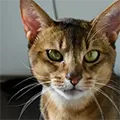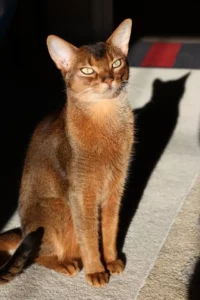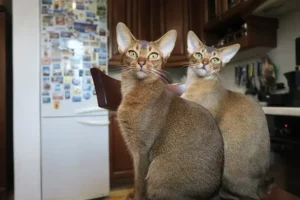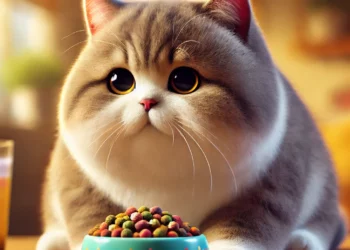
Abyssinians are elegant, medium-sized cats with a strong, lithe body and slender legs. They have a rounded head, with characteristic small tufts at the tips of the ears and large, almond-shaped eyes. Its short, close-fitting coat has a very characteristic appearance.
Summary
The Abyssinian cat, often referred to as the “Aby,” is one of the most distinctive and recognized cat breeds in the world. With its ticked coat, expressive almond-shaped eyes, and muscular body, the Abyssinian has captivated cat lovers for centuries. This breed is known for its playful, energetic, and affectionate nature, making it a beloved companion in many households. In this comprehensive guide, we will explore the history, physical characteristics, personality, grooming needs, dietary requirements, and much more about the Abyssinian cat.
Whether you’re considering adding an Abyssinian to your family or you’re just curious about this fascinating breed, this article will provide you with all the information you need.
History of the Abyssinian Cat
Origins: Myth vs. Reality
The Abyssinian cat’s origins are surrounded by a rich tapestry of myths and legends. Often linked to ancient Egypt, it’s easy to see why people might believe these cats were revered by pharaohs. Their regal appearance and sleek, muscular bodies are reminiscent of the cats depicted in Egyptian art. However, genetic evidence suggests a different story.
Modern research indicates that the Abyssinian cat likely originated from the coastal regions of the Indian Ocean and parts of Southeast Asia. It’s believed that British and Dutch traders brought these cats to Europe in the 19th century from ports such as Calcutta, India, or the islands of Indonesia.
The Abyssinian in Europe and America
The first Abyssinian cats were exhibited at the Crystal Palace Cat Show in London in 1871. The breed gained immediate attention due to its unusual coat and striking appearance. The name “Abyssinian” likely comes from Zula, a cat that was said to have been imported from Abyssinia (modern-day Ethiopia).
By the early 20th century, the breed had gained popularity in the United States as well, where it was further developed and standardized. World War II nearly led to the extinction of the breed in Europe, but fortunately, Abyssinians in the U.S. helped to revive the population.
Physical Characteristics
Coat and Colors
One of the most defining features of the Abyssinian cat is its coat. The Abyssinian’s fur is short, dense, and exhibits a unique “ticked” pattern, where each hair is banded with multiple colors. This ticking gives the coat a rich, vibrant appearance. The breed standard includes several coat colors: ruddy, red, blue, and fawn, with the ruddy being the most common and traditional.
The fur is smooth to the touch and lies close to the body, emphasizing the cat’s sleek and muscular build. Each strand of hair is lighter at the base and gradually darkens towards the tip, creating a subtle, almost shimmering effect.
Size and Build
Abyssinians are medium-sized cats, typically weighing between 6 to 10 pounds. They have a well-proportioned, muscular body with long, slender legs. Their ears are large and pointed, giving them an alert, curious expression, and their eyes are almond-shaped, ranging in color from gold to green.
Their overall appearance is one of grace and agility, with a lithe, athletic build that reflects their active and energetic nature.
Personality and Behavior
Energetic and Playful
Abyssinians are known for their high energy levels and playful demeanor. These cats are always on the move, exploring their surroundings, climbing to high places, and engaging in interactive play. They are highly intelligent and require mental stimulation, often inventing their own games or figuring out puzzles to keep themselves entertained.
Abyssinians are sometimes referred to as the “clowns of the cat kingdom” due to their playful antics and their ability to make their owners laugh. They love to chase after toys, jump onto high perches, and even learn tricks. This breed is not content to be a passive observer; they want to be in the middle of the action, whether it’s chasing a feather toy or “helping” you with household tasks.
Affectionate and Social
Despite their independent streak, Abyssinians are very affectionate and form strong bonds with their human families. They are social cats that enjoy the company of people and other animals. They are known to follow their owners from room to room, always curious about what’s happening next. However, they are not typically lap cats; they prefer to be active and involved rather than sitting still for long periods.
Abyssinians are also relatively quiet cats. They communicate with soft chirps and trills rather than loud meows, which many owners find endearing.
Interaction with Other Pets
Abyssinians generally get along well with other pets, including dogs and other cats. Their playful and curious nature makes them open to forming friendships with other animals. However, because of their high energy levels, they might be too much for more laid-back pets. It’s important to ensure that other pets in the household can keep up with the Abyssinian’s playful antics or have their own space to retreat to if needed.
Training and Intelligence
Abyssinians are highly intelligent cats and can be trained to perform tricks, walk on a leash, and even fetch. They enjoy interactive toys and games that challenge their minds, such as puzzle feeders and toys that dispense treats. Their intelligence also means they can be mischievous, figuring out how to open doors or cupboards to get what they want.
Grooming and Maintenance
Coat Care
Despite their short coat, Abyssinians require regular grooming to keep their fur in top condition. A weekly brushing is usually sufficient to remove loose hairs and distribute natural oils throughout the coat, keeping it shiny and healthy. Due to their low shedding, they are often considered a good choice for people with mild allergies, although no cat breed is truly hypoallergenic.
Baths are rarely necessary, but if you do bathe your Abyssinian, ensure you use a cat-specific shampoo to avoid drying out their skin.
Dental Care
Dental health is particularly important for Abyssinians, as they are prone to periodontal disease. Regular brushing of your cat’s teeth with a vet-approved toothpaste can help prevent the buildup of plaque and tartar. It’s also advisable to schedule regular dental check-ups with your veterinarian.
Nail and Ear Care
Regularly trimming your Abyssinian’s nails is essential to prevent overgrowth and potential injury. Additionally, check their ears weekly for signs of dirt or infection. Clean their ears with a soft cloth and a vet-recommended ear cleaner if necessary, but avoid using cotton swabs, which can damage the ear canal.
Diet and Nutrition
Nutritional Requirements
Abyssinians are active cats with high energy needs, so their diet should be rich in high-quality protein to support their muscular build and active lifestyle. A balanced diet of wet and dry cat food, supplemented with occasional treats, is generally recommended. Wet food can help keep them hydrated, while dry food is beneficial for dental health.
It’s important to choose a diet that is appropriate for your cat’s age, weight, and health status. Kittens, adult cats, and senior cats have different nutritional needs, so consult with your veterinarian to determine the best feeding plan for your Abyssinian.
Portion Control and Weight Management
Because Abyssinians are so active, they are less prone to obesity than some other breeds. However, it’s still crucial to monitor their weight and avoid overfeeding. Provide measured portions according to the guidelines on your cat food packaging and adjust as necessary based on your cat’s activity level and overall health.
Health and Lifespan
Common Health Issues
While Abyssinians are generally healthy cats, they are predisposed to certain genetic health issues. Some of the common conditions seen in this breed include:
- Periodontal Disease: This is a common issue in Abyssinians and can lead to more serious health problems if not managed properly. Regular dental care is crucial to prevent this condition.
- Patellar Luxation: This condition involves the dislocation of the kneecap and can cause pain and mobility issues. In severe cases, surgery may be required.
- Progressive Retinal Atrophy (PRA): This is a degenerative eye disease that can lead to blindness. Regular eye check-ups can help in early detection and management.
- Renal Amyloidosis: This genetic condition affects the kidneys and can lead to renal failure. It’s important to have regular check-ups to monitor kidney function, especially as your cat ages.
Lifespan
With proper care and regular veterinary visits, Abyssinians typically live between 12 to 15 years, although some have been known to live even longer. Providing a healthy diet, regular exercise, and routine health checks can help ensure your Abyssinian leads a long, healthy life.
Tips for Living with an Abyssinian
Provide Plenty of Stimulation
Abyssinians are high-energy cats that require plenty of mental and physical stimulation. Makemental and physical stimulation. Make sure your home is equipped with plenty of toys, scratching posts, and climbing structures to keep your Abyssinian entertained. This breed loves to climb, so investing in tall cat trees or wall-mounted shelves will give them the height they crave.
Interactive Play
Spend time each day engaging in interactive play with your Abyssinian. Games like fetch, laser pointer chases, and puzzle toys will not only keep them physically active but also mentally stimulated. These cats are known for their intelligence, so activities that challenge their problem-solving skills will be particularly appreciated.
Companionship
Abyssinians are social cats and do best in homes where they have companionship, either from their human family members or from another pet. If you’re often away from home, consider getting a second cat to keep your Aby company. They thrive on social interaction and can become lonely or bored if left alone for too long.
Regular Vet Check-ups
Due to their susceptibility to certain genetic conditions, regular veterinary check-ups are crucial for Abyssinians. Early detection of health issues like periodontal disease, patellar luxation, and progressive retinal atrophy can make a significant difference in treatment outcomes. Schedule annual or bi-annual vet visits to keep your Abyssinian in optimal health.
FAQs about Abyssinian Cats
Are Abyssinians good pets for families with children?
Yes, Abyssinians make excellent pets for families with children. Their playful and energetic nature makes them great companions for active children, and their affectionate personality ensures they bond well with family members. However, younger children should be taught how to handle pets gently to avoid any accidental injuries.
How much grooming do Abyssinians require?
Abyssinians are relatively low-maintenance when it comes to grooming. Their short, dense coats only require a weekly brushing to remove loose hairs and maintain a healthy shine. They are low shedders, which can be a bonus for people with mild allergies.
What should I feed my Abyssinian?
Abyssinians require a diet high in protein to support their active lifestyle. A balanced diet of wet and dry cat food is recommended, with occasional treats. Always consult your veterinarian to determine the best dietary plan for your cat, considering factors like age, weight, and health.
Do Abyssinians get along with other pets?
Generally, Abyssinians get along well with other pets, including dogs and other cats. Their social and playful nature makes them open to forming bonds with other animals. However, they may be too energetic for more laid-back pets, so it’s important to monitor interactions, especially at first.
Are Abyssinians prone to any health issues?
Yes, Abyssinians are prone to certain health issues, including periodontal disease, patellar luxation, progressive retinal atrophy, and renal amyloidosis. Regular veterinary check-ups are essential for early detection and management of these conditions
Latest on Cat Breeds
Effects Of Music On Cats: Do Cats Enjoy Music?
For many cat owners, music is a regular part of daily life. We play it while cooking, cleaning, relaxing, or...
Myths And Truths About Feeding Your Cat
Feeding your cat is more than just picking up the nearest bag of kibble. It’s about providing balanced nutrition to...
How To Ensure Your Cat Drinks Enough Water
Water is essential for life, and just like humans, cats need adequate hydration to maintain their health and well-being. However,...
How to Spot and Prevent Parasites In Cats
Parasites are an unfortunate but common issue that many cat owners will face at some point. These unwelcome visitors can...











